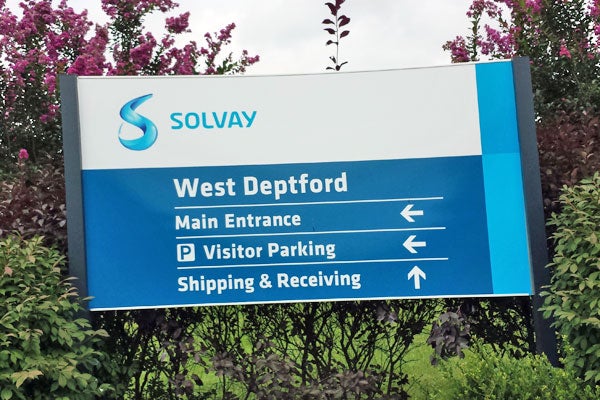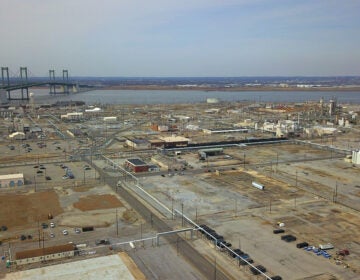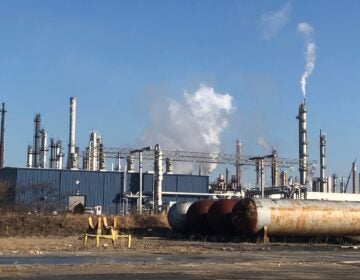South Jersey company confirms use of unregulated replacement for toxic chemical
But Solvay says it’s not responsible for environmental contamination with "legacy" chemicals.

Solvay Specialty Polymers said it is using unnamed “process aids” at its West Deptford facility as a substitute for PFNA. (Delaware Riverkeeper Network)
This story originally appeared on NJ Spotlight.
___
A South Jersey company has been using an unregulated replacement for a toxic chemical at its Gloucester County plant but denied that it is responsible for polluting water, air and soil with a related chemical the company had been using.
Solvay Specialty Polymers said it is using unnamed “process aids” at its West Deptford facility as a substitute for PFNA (perfluorononanoic acid), a type of PFAS chemical that has been linked to cancer and other serious illnesses, and was found at very high levels in a public water well at nearby Paulsboro in 2013.
“Solvay uses these process aids as an alternative to a PFNA-containing material, which was phased out at West Deptford in 2010,” it said in a statement late Friday.
PFNA, which has been used in a variety of consumer products including nonstick cookware, is one of thousands of so-called forever chemicals that don’t break down in the environment, and so persist for years after their manufacture or use has ended. In 2018, New Jersey finalized one of the nation’s strictest health limits on the chemical in drinking water.
Chemical companies are developing replacements for some PFAS chemicals — formally known as per- and polyfluoroalkyl substances — that are increasingly subjected to strict health limits in drinking water, as set by states including New Jersey. Some scientists and regulators fear the new chemicals may be just as toxic as those they replace, but little is known about them and they are not subject to regulation.
Some advocates for stricter limits on the chemicals compare regulating them one by one to playing ‘whack-a-mole’ because replacements are found as soon as health limits are set on so-called legacy chemicals. Some argue it would make more sense to set health limits for the entire class.
Evidence of toxicity
Solvay did not answer questions on whether the “process aids” are toxic, whether they have been found in nearby drinking water wells, or how long they have been in use, but it indicated that toxicity has been found in the new material.
“Solvay has provided detailed toxicology information on its current process aids to both the U.S. EPA and the NJDEP with appropriate confidentiality designations,” the company said.
According to a story in Consumer Reports on Oct. 1, Solvay has been using a replacement chemical at West Deptford for years despite not having developed an accepted means of allowing regulators or independent researchers to judge whether it is entering the environment. The story was based on more than 240 pages of filings obtained through a public records request, Consumer Reports said.
The same concern was highlighted in a June paper published by the American Association for the Advancement of Science in its journal, Science. The article, whose authors include those from New Jersey’s Department of Environmental Protection and the U.S. Environmental Protection Agency, said it had “tentatively identified” a molecule called CIPFPECA in soil sampled near Solvay’s plant.
The testing was part of an effort by environmental chemists to identify a new generation of chemicals that are being used by manufacturers as substitutes for “legacy” PFAS following a 2006 agreement between EPA and major chemical companies to phase out some of the older chemicals because of increasing health concerns. The identity of the replacements is typically treated as “confidential business information,” the Science paper said.
In September, the use of replacement chemicals in South Jersey was reported by the journal Environmental Science and Technology Letters, which said concentrations near West Deptford are estimated to exceed state drinking water standards for PFOA and PFNA, two of the PFAS chemicals that New Jersey has recently regulated.
Solvay: ‘No clear evidence’
In its statement, Belgium-based Solvay said there’s no clear evidence that the molecule identified in the Science paper is the same as the “process aid” being used at the plant.
“There is and has been no confirmed chemical identity between the process aids that Solvay currently uses and the substances reported in the recent Science and Environmental Science & Technology studies,” the company said. “These analyses, which were performed without any Solvay inquiry or consultation, are not substitutes for concrete analytical data using verified analytical standards that can be scientifically compared with Solvay’s current process aids.”
Tracy Carluccio, a longtime anti-PFAS campaigner with the environmental group Delaware Riverkeeper Network, accused the company of refusing to identify its replacement material to researchers.
“Solvay knows very well what the chemical identity is of the replacement compound(s) they are using but they did not provide that to the scientists who were doing the study,” she said.
She argued that Solvay is wrong to conceal the chemical’s identity on the grounds of confidential business information in light of concerns about its public health risks. “It’s simply not right to keep this secret,” she said.
EPA, which does not regulate PFAS but is considering setting health limits for two of the chemicals, confirmed that the CIPFPECA molecules had been found near the Solvay plant but said the authors of the two papers did not investigate the molecules’ health effects or the levels found in surface and well water.
The DEP did not respond to several requests for comment from NJ Spotlight News, and has not replied to two letters from Delaware Riverkeeper Network seeking information on the replacement chemicals being used by Solvay.
Environmental group looks for answers
In the latest letter to DEP Commissioner Catherine McCabe, on Oct. 12, DRN asked whether Solvay had confirmed the presence of CIPFPECA around its plant, whether it had been released into water, soil or air, and when the company started using the material. It also asked whether the department will require Solvay to stop using the substance.
“The public has a right to know what is in the air we breathe and the water we drink and how the presence in our environment of ClPFPECA, the compound registered to the Solvay Specialty Polymers to replace PFNA, could affect New Jerseyans’ health,” DRN said.
The DEP first found PFNA and two other PFAS chemicals in a Paulsboro public drinking water well in 2009. In 2013, it directed the Paulsboro utility to test the well, where PFNA was found at about 11 times the level that DEP has since set as safe for human consumption in drinking water.
DEP officials have blamed Solvay for the contamination, and the company has been testing for, and cleaning up, the chemicals since 2015. In 2019, DEP filed a “Directive” to Solvay and four other chemical companies to pay for the investigation and cleanup of PFAS, saying they were responsible for “significant contamination” of the state’s air and water. The department later said the directive would take years to resolve.
Now, the company says it will continue to work with the DEP to investigate and clean up “any PFAS impacts attributable to its West Deptford facility.”
But in a new lawsuit, the company said it is not responsible for the PFNA contamination, which it said was caused by the nearby Paulsboro Refining Company (PRC) which used firefighting foam containing the chemicals to disperse a 2012 oil spill, and facilitated firefighting exercises using the foam at its site by the Delaware River for at least 20 years.
One company sues another
The suit said that local hydrology shows that groundwater flows from the West Deptford plant away from the Paulsboro well where the contamination was found, and so Solvay cannot have been the source. It also cited air-dispersion modeling showing that no significant amount of two PFAS chemicals can have been spread by air beyond the boundaries of the plant. And it said it found no PFNA when it sampled water in the Delaware River in December 2014.
“There is no data showing that any PFNA or PFOA allegedly attributable to the West Deptford Facility traveled, via surface water and then groundwater, to reach Paulsboro Well No. 7,” the company said in the complaint against PRC, filed in the New Jersey Superior Court for Gloucester County on Oct. 5.
PFOA (perfluorooctanoic acid) was made famous by the 2019 movie “Dark Waters” that tells the story of an attorney obtaining compensation for people who drank water contaminated by the chemical produced by a DuPont plant in Parkersburg, West Virginia.
Solvay said it agreed with DEP in December 2014 to investigate and treat for PFAS contamination because — even though it did not believe then it was responsible — it was not confident in that claim, but now is. It said it has spent more than $30 million on testing for and cleaning up PFAS in Gloucester County, including $3.5 million to install a PFAS filter on the Paulsboro well.
PBF, the parent company of the refinery operator, did not immediately respond to a request for comment.
In 2014, the Borough of Paulsboro threatened to sue Solvay unless it ensured long-term protection for the town’s water supply, prompting the company to pay for the filtration system on the contaminated well.
In the suit, Solvay also accused the DEP of failing to investigate its claim that the refinery, and a fire-training site there, was the source of PFAS contamination.
The suit seeks a court judgment that PRC is liable for the cleanup and removal of PFAS chemicals in the Paulsboro well, and elsewhere in Gloucester County, and should reimburse Solvay for that work.
Delaware Riverkeeper Network’s Carluccio said the suit shows Solvay trying to shift the blame to one or more other parties despite evidence — in a 2008 statement to the EPA — that it was responsible for at least some of the PFNA contamination.
“The fact that there may be multiple polluters doesn’t exonerate any one company, especially Solvay, because they are the company that used PFNA in their processing and they released it to the environment, contaminating water supplies,” she said.
“Any and all sources of PFAS contamination must be found and if there is any ongoing release, it must be stopped,” she said.
WHYY is your source for fact-based, in-depth journalism and information. As a nonprofit organization, we rely on financial support from readers like you. Please give today.





